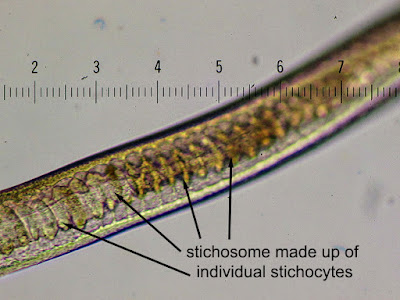Answer: Female Trichuris sp.
The most likely etiology is T. trichiura. However, as several readers mentioned, human infection with T. vulpis has rarely been reported and the adult worm has a similar appearance. The two worms are differentiated primarily by their eggs, with T. vulpis eggs being nearly twice as large as T. trichiura eggs. The only eggs we see in this case are immature and intrauterine; therefore it is not possible to use the eggs to help us differentiate the two worms.
Here are some of the key diagnostic features of this case:
Note that the head is at the slender end (all the better for embedding into the large bowel mucosa), while the larger end (containing the uterus and eggs) hangs free in the bowel lumen. We can tell that this is a female worm because of the eggs in the uterus (below) and because the tail is not coiled like a male's tail would be.
Sunday, April 15, 2018
Subscribe to:
Post Comments (Atom)






No comments:
Post a Comment